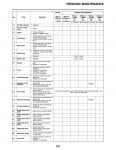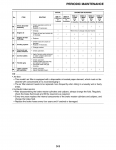Here is the full service manual for the R3:
Yamaha YZF-R3 Service Manual.pdf
Basically gives you a step by step guide on how Yamaha wants things done. Endless amounts of youtube's on each service interval and how to do specific services on the bike. My suggestion would be to try what you can and take it to a mechanic / someone reputable for a once over. Sometimes you don't know what you don't know and can miss things as mentioned above.
That being said it is a fairly new bike with low KM's so a lot of it is straightforward. if you have some level of mechanical inclination and patience than pretty much everything can be done by yourself. Bikes are relatively simple, small scale, and you can access nearly every part without major disassembly (compared to a compact car for example). I'd imagine most mistakes come from people being overconfident and not understanding what they are doing/referencing a manual, or being a hack and not buying the right tools.
honestly the hardest / frustrating part about doing the 6000km service on an R3 is figuring out how the fairings are removed / reassembled. Its a bit of a jigsaw on this bike.
just looking over the owner's manual service interval the big ticket items are:
Fuel Injection - synchronization. This is done by "syncing the throttle bodies" using a carburetor tuner (look up the motion pro one). This is one of those services that looks way more complicated that it seems but is really dead simple once you understand the process. A lot of people question if this is worth doing - I would suggest not skipping it. It relieved the heavy engine braking i developed + improved the overall smoothness on my bike.
Front / Rear brake - for obvious reasons this is not something to skip over and probably a little intimidating for a beginner. Brake pads should still be good at 6000km. Do a visual inspection to confirm there is not any leaks, check brake light switches, deglaze rotors. Brake fluid does degrade even if the bike was sitting most of its life - If it still has the factory fluid you will want to get this changed out. Relatively straightforward procedure however getting a good lever feel (no air in the system) can be a little tricky.
Wheels / Wheel bearings - check runout. I'd bet this gets skipped by most people. You can measure the unwanted variances / play using a dial indicator. Realistically on a recent low mileage bike getting the wheels off the ground, checking they spin freely and do not rock back/forth is what most people are doing. Runout can also be related to tire / tire mounting - check for any flatspots and give the rubber a good once over.
Steering bearing check - any weird clicking, clunking, resistance / handling issues will give this away. You need get the bike off the ground with zero weight on the forks and check for any movement. Fork should not move in any direction it isn't supposed to. Probably fine unless the previous owner was really bad at wheelies.
clutch - relatively easy adjustment that any rider should be familiar with doing. Check the lever snaps back (no significant drag), and make sure there is no cable fraying. May need to be cleaned / lubricated.
Oil change & filter - the gateway drug of home wrenching. Very simple process on this bike. If you are going to start anywhere this is the first service to build your confidence up. The oil change interval is short compared to most bigger bikes so expect to be doing this 2-3 times a year.
The rest of the service items are basic visual checks and confirming things are still torqued down:
Anything rubber (e.g breather hoses, coolant hoses, etc.) - check that the rubber is pliable / no cracks. Take a look at the hose clamps for any movement. * There was a recall on the 2017 for the coolant hose due to bad clamps, make sure the previous owner did this.*
Tires - at 6000km you probably are only at halfway to a third through the OEM tire life. Be mindful that tires are good for about 5 years before the rubber starts to go bad.
suspension - look for any fluid leak near the seals. IMO this is really something that should get checked more often than every couple thousand kms. Clean out any dirt that's caked on the seals. unlikely you'd be seeing any issues this early on.
bolts - go through with a socket set and confirm everything seems decently torqued. I use a torque wrench on things like the brake mounting bolts, triple clamp bolt, etc.
IIRC the dealership I bought from was offering the 1st + 2nd service for $400 at time of purchase. Doesn't sound that crazy until you realize how routine most of this stuff is and how little work it can be. I ended up taking that money and getting all the service specific tools i eventually needed instead.
I wouldn't be too worried about not having a record of the first service. its basically just an oil change (although that part is REALLY important it got done).




